Paper Menu >>
Journal Menu >>
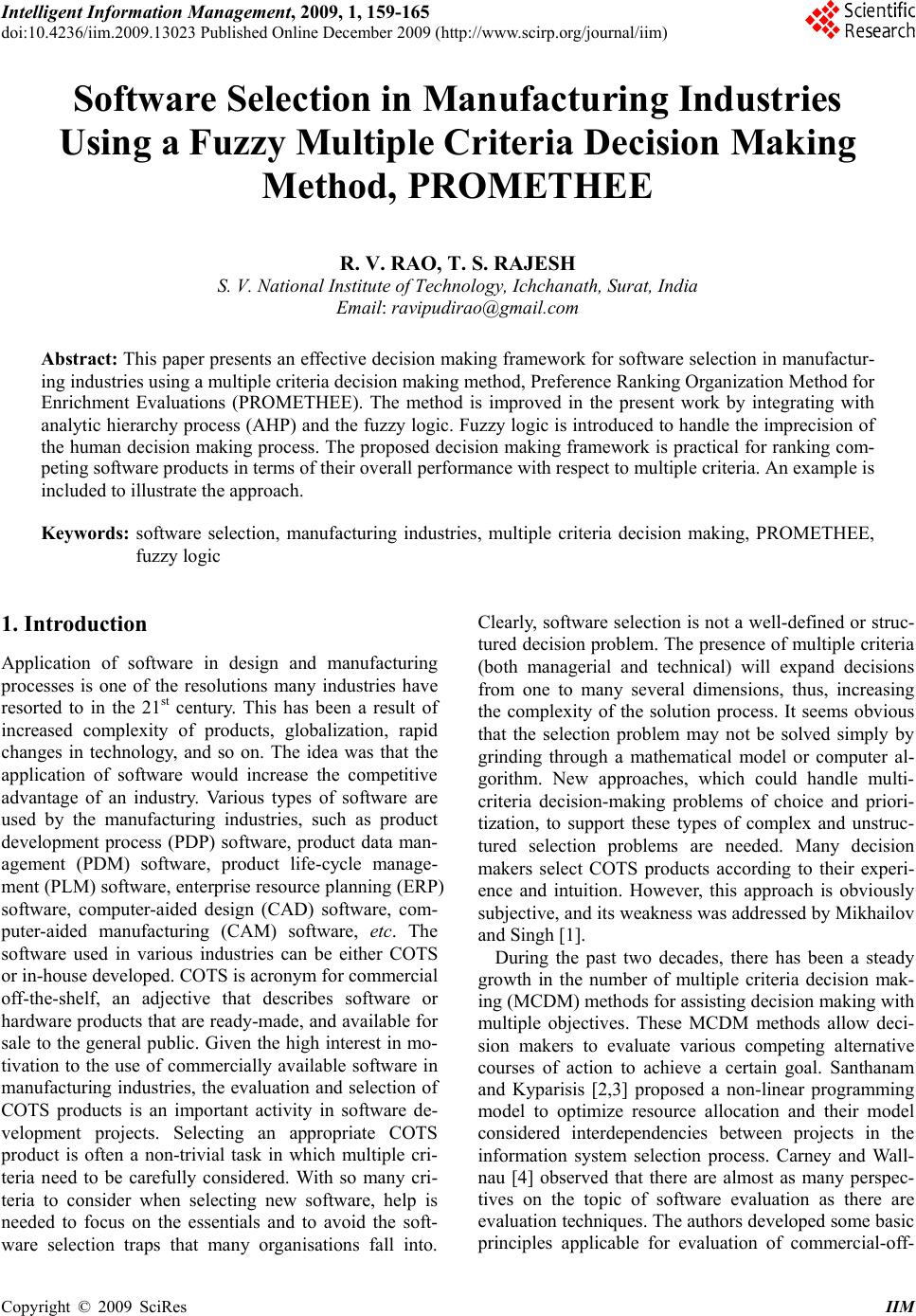 Intelligent Information Management, 2009, 1, 159-165 doi:10.4236/iim.2009.13023 Published Online December 2009 (http://www.scirp.org/journal/iim) Copyright © 2009 SciRes IIM 159 Software Selection in Manufacturing Industries Using a Fuzzy Multiple Criteria Decision Making Method, PROMETHEE R. V. RAO, T. S. RAJESH S. V. National Institute of Technology, Ichchanath, Surat, India Email: ravipudirao@gmail.com Abstract: This paper presents an effective decision making framework for software selection in manufactur- ing industries using a multiple criteria decision making method, Preference Ranking Organization Method for Enrichment Evaluations (PROMETHEE). The method is improved in the present work by integrating with analytic hierarchy process (AHP) and the fuzzy logic. Fuzzy logic is introduced to handle the imprecision of the human decision making process. The proposed decision making framework is practical for ranking com- peting software products in terms of their overall performance with respect to multiple criteria. An example is included to illustrate the approach. Keywords: software selection, manufacturing industries, multiple criteria decision making, PROMETHEE, fuzzy logic 1. Introduction Application of software in design and manufacturing processes is one of the resolutions many industries have resorted to in the 21st century. This has been a result of increased complexity of products, globalization, rapid changes in technology, and so on. The idea was that the application of software would increase the competitive advantage of an industry. Various types of software are used by the manufacturing industries, such as product development process (PDP) software, product data man- agement (PDM) software, product life-cycle manage- ment (PLM) software, enterprise resource planning (ERP) software, computer-aided design (CAD) software, com- puter-aided manufacturing (CAM) software, etc. The software used in various industries can be either COTS or in-house developed. COTS is acronym for commercial off-the-shelf, an adjective that describes software or hardware products that are ready-made, and available for sale to the general public. Given the high interest in mo- tivation to the use of commercially available software in manufacturing industries, the evaluation and selection of COTS products is an important activity in software de- velopment projects. Selecting an appropriate COTS product is often a non-trivial task in which multiple cri- teria need to be carefully considered. With so many cri- teria to consider when selecting new software, help is needed to focus on the essentials and to avoid the soft- ware selection traps that many organisations fall into. Clearly, software selection is not a well-defined or struc- tured decision problem. The presence of multiple criteria (both managerial and technical) will expand decisions from one to many several dimensions, thus, increasing the complexity of the solution process. It seems obvious that the selection problem may not be solved simply by grinding through a mathematical model or computer al- gorithm. New approaches, which could handle multi- criteria decision-making problems of choice and priori- tization, to support these types of complex and unstruc- tured selection problems are needed. Many decision makers select COTS products according to their experi- ence and intuition. However, this approach is obviously subjective, and its weakness was addressed by Mikhailov and Singh [1]. During the past two decades, there has been a steady growth in the number of multiple criteria decision mak- ing (MCDM) methods for assisting decision making with multiple objectives. These MCDM methods allow deci- sion makers to evaluate various competing alternative courses of action to achieve a certain goal. Santhanam and Kyparisis [2,3] proposed a non-linear programming model to optimize resource allocation and their model considered interdependencies between projects in the information system selection process. Carney and Wall- nau [4] observed that there are almost as many perspec- tives on the topic of software evaluation as there are evaluation techniques. The authors developed some basic principles applicable for evaluation of commercial-off- 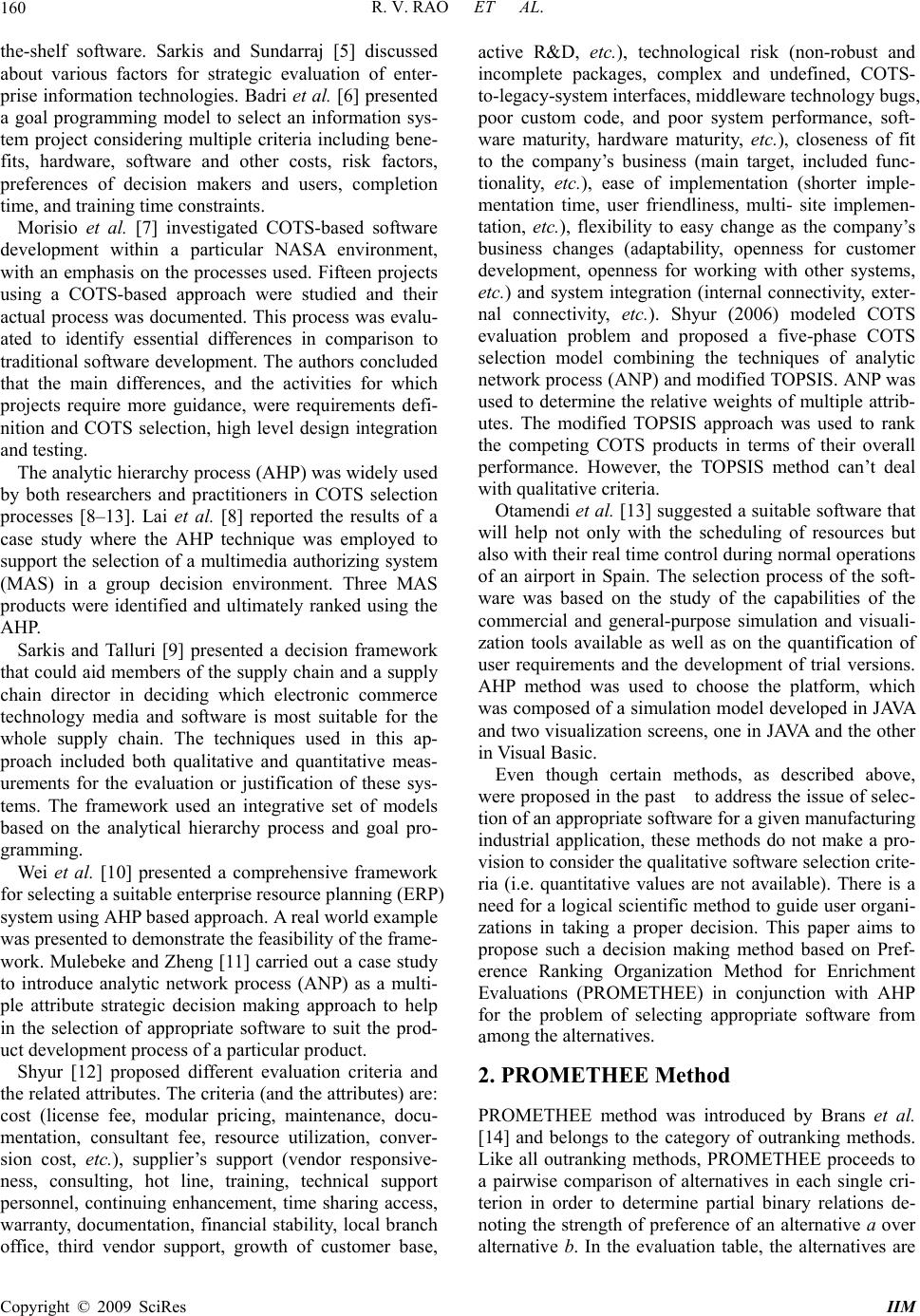 R. V. RAO ET AL. 160 the-shelf software. Sarkis and Sundarraj [5] discussed about various factors for strategic evaluation of enter- prise information technologies. Badri et al. [6] presented a goal programming model to select an information sys- tem project considering multiple criteria including bene- fits, hardware, software and other costs, risk factors, preferences of decision makers and users, completion time, and training time constraints. Morisio et al. [7] investigated COTS-based software development within a particular NASA environment, with an emphasis on the processes used. Fifteen projects using a COTS-based approach were studied and their actual process was documented. This process was evalu- ated to identify essential differences in comparison to traditional software development. The authors concluded that the main differences, and the activities for which projects require more guidance, were requirements defi- nition and COTS selection, high level design integration and testing. The analytic hierarchy process (AHP) was widely used by both researchers and practitioners in COTS selection processes [8–13]. Lai et al. [8] reported the results of a case study where the AHP technique was employed to support the selection of a multimedia authorizing system (MAS) in a group decision environment. Three MAS products were identified and ultimately ranked using the AHP. Sarkis and Talluri [9] presented a decision framework that could aid members of the supply chain and a supply chain director in deciding which electronic commerce technology media and software is most suitable for the whole supply chain. The techniques used in this ap- proach included both qualitative and quantitative meas- urements for the evaluation or justification of these sys- tems. The framework used an integrative set of models based on the analytical hierarchy process and goal pro- gramming. Wei et al. [10] presented a comprehensive framework for selecting a suitable enterprise resource planning (ERP) system using AHP based approach. A real world example was presented to demonstrate the feasibility of the frame- work. Mulebeke and Zheng [11] carried out a case study to introduce analytic network process (ANP) as a multi- ple attribute strategic decision making approach to help in the selection of appropriate software to suit the prod- uct development process of a particular product. Shyur [12] proposed different evaluation criteria and the related attributes. The criteria (and the attributes) are: cost (license fee, modular pricing, maintenance, docu- mentation, consultant fee, resource utilization, conver- sion cost, etc.), supplier’s support (vendor responsive- ness, consulting, hot line, training, technical support personnel, continuing enhancement, time sharing access, warranty, documentation, financial stability, local branch office, third vendor support, growth of customer base, active R&D, etc.), technological risk (non-robust and incomplete packages, complex and undefined, COTS- to-legacy-system interfaces, middleware technology bugs, poor custom code, and poor system performance, soft- ware maturity, hardware maturity, etc.), closeness of fit to the company’s business (main target, included func- tionality, etc.), ease of implementation (shorter imple- mentation time, user friendliness, multi- site implemen- tation, etc.), flexibility to easy change as the company’s business changes (adaptability, openness for customer development, openness for working with other systems, etc.) and system integration (internal connectivity, exter- nal connectivity, etc.). Shyur (2006) modeled COTS evaluation problem and proposed a five-phase COTS selection model combining the techniques of analytic network process (ANP) and modified TOPSIS. ANP was used to determine the relative weights of multiple attrib- utes. The modified TOPSIS approach was used to rank the competing COTS products in terms of their overall performance. However, the TOPSIS method can’t deal with qualitative criteria. Otamendi et al. [13] suggested a suitable software that will help not only with the scheduling of resources but also with their real time control during normal operations of an airport in Spain. The selection process of the soft- ware was based on the study of the capabilities of the commercial and general-purpose simulation and visuali- zation tools available as well as on the quantification of user requirements and the development of trial versions. AHP method was used to choose the platform, which was composed of a simulation model developed in JAVA and two visualization screens, one in JAVA and the other in Visual Basic. Even though certain methods, as described above, were proposed in the past to address the issue of selec- tion of an appropriate software for a given manufacturing industrial application, these methods do not make a pro- vision to consider the qualitative software selection crite- ria (i.e. quantitative values are not available). There is a need for a logical scientific method to guide user organi- zations in taking a proper decision. This paper aims to propose such a decision making method based on Pref- erence Ranking Organization Method for Enrichment Evaluations (PROMETHEE) in conjunction with AHP for the problem of selecting appropriate software from among the alternatives. 2. PROMETHEE Method PROMETHEE method was introduced by Brans et al. [14] and belongs to the category of outranking methods. Like all outranking methods, PROMETHEE proceeds to a pairwise comparison of alternatives in each single cri- terion in order to determine partial binary relations de- noting the strength of preference of an alternative a over alternative b. In the evaluation table, the alternatives are Copyright © 2009 SciRes IIM  R. V. RAO ET AL. 161 evaluated on different criteria. These evaluations involve mainly quantitative data. The implementation of PRO- METHEE requires additional types of information, namely: information on the relative importance that is the weights of the criteria considered, and information on the decision maker preference func- tion, which he/she uses when comparing the contribution of the alternatives in terms of each separate criterion. It may be added here that the original PROMETHEE method can effectively deal mainly with quantitative criteria. However, there exists some difficulty in the case of qualitative criteria. In the case of a qualitative crite- rion (i.e. quantitative value is not available); a ranked value judgment on a fuzzy conversion scale is adopted in this paper. By using fuzzy set theory, the value of the criteria can be first decided as linguistic terms, converted into corresponding fuzzy numbers and then converted to the crisp scores. Rao (2007) had presented a logical ap- proach based on the work of Cheng and Hwang (1992). The presented numerical approximation system system- atically converts linguistic terms to their corresponding fuzzy numbers. It contains eight conversion scales and in the present work, an eleven-point scale is considered for better understanding and representation. Table 1 is sug- gested which represents the selection criterion on a qualitative scale using fuzzy logic, corresponding to the fuzzy conversion scale as shown in Figure 1 and helps the users in assigning the values. For more details, one can refer to Chen and Hwang (1992). Once a qualitative criterion is represented on a scale then the alternatives can be compared with each other on this criterion in the same manner as that for quantitative criteria. The methodology presented in this paper for software selection in the manufacturing environment using im- proved PROMETHEE method is described below: Step-1: Identify the selection criteria for the considered decision making problem of software selection and short- list the alternative softwares on the basis of the identified Figure 1. Linguistic terms to fuzzy numbers conversion criteria satisfying the requirements. A quantitative or qualitative value or its range may be assigned to each identified criterion as a limiting value or threshold value for its acceptance for the considered application. An al- ternative software with each of its criterion, meeting the criterion, may be short-listed. The short-listed alterna- tives may then be evaluated using the proposed method- ology. The values associated with the criteria for different al- ternatives may be based on the available data or may be the estimations made by the decision maker or a group of decision makers. In the case of group decision making, the values estimated by the decision makers for different criteria for different alternatives may be different. In such cases, the value of a criterion for an alternative may be determined by averaging the estimated values given by the group of decision makers for that criterion for that alternative. The same averaging procedure may be car- ried out for other criteria. Alternately, the group may decide the values of criteria for different alternatives based on group consensus. Step-2: 1) After short-listing the alternatives, prepare a deci- sion table including the measures or values of all criteria for the short-listed alternatives. 2) The original PROMETHEE method has no system- atic way of assigning the weights of relative importance to the criteria. Hence, use of analytic hierarchy process (AHP) is suggested in this paper to be used in conjunc- tion with PROMETHEE for this purpose. The steps are explained below: a) Find out the relative importance of different criteria with respect to the objective. To do so, one has to con- struct a pair-wise comparison matrix using a scale of relative importance. The judgments are entered using the fundamental scale of the AHP. An attribute compared with it is always assigned the value 1 so the main diago- nal entries of the pair-wise comparison matrix are all 1. The numbers 3, 5, 7, and 9 correspond to the verbal judgments ‘moderate importance’, ‘strong importance’, ‘very strong importance’, and ‘absolute importance’ (with 2, 4, 6, and 8 for compromise between the previous values). Assuming M criteria, the pair-wise comparison of attribute i with attribute j yields a square matrix A1 where rij denotes the comparative importance of attribute i with respect to attribute j. In the matrix, rij = 1 when i = j and rji = 1 / rij 11 12131 21 22232M 31 32333 123 123 1 2 (1) 3 M M MM MMM M Criterion rrr r rrr r AIr rrr rrr r M Copyright © 2009 SciRes IIM 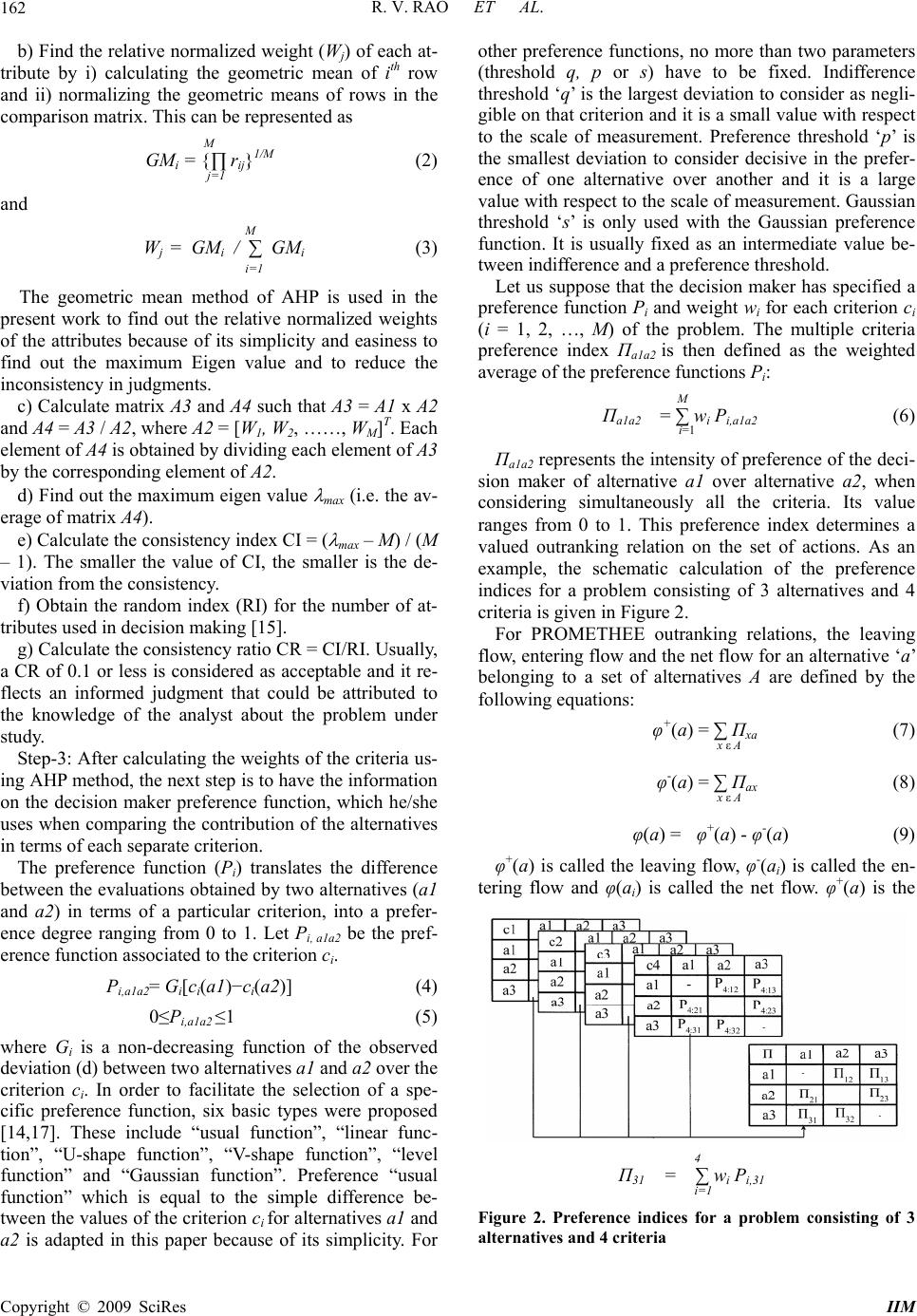 R. V. RAO ET AL. 162 b) Find the relative normalized weight (Wj) of each at- tribute by i) calculating the geometric mean of ith row and ii) normalizing the geometric means of rows in the comparison matrix. This can be represented as M GMi = {∏ rij}1/M (2) j=1 and M Wj = GMi / ∑ GMi (3) i=1 The geometric mean method of AHP is used in the present work to find out the relative normalized weights of the attributes because of its simplicity and easiness to find out the maximum Eigen value and to reduce the inconsistency in judgments. c) Calculate matrix A3 and A4 such that A3 = A1 x A2 and A4 = A3 / A2, where A2 = [W1, W2, ……, WM]T. Each element of A4 is obtained by dividing each element of A3 by the corresponding element of A2. d) Find out the maximum eigen value max (i.e. the av- erage of matrix A4). e) Calculate the consistency index CI = ( max – M) / (M – 1). The smaller the value of CI, the smaller is the de- viation from the consistency. f) Obtain the random index (RI) for the number of at- tributes used in decision making [15]. g) Calculate the consistency ratio CR = CI/RI. Usually, a CR of 0.1 or less is considered as acceptable and it re- flects an informed judgment that could be attributed to the knowledge of the analyst about the problem under study. Step-3: After calculating the weights of the criteria us- ing AHP method, the next step is to have the information on the decision maker preference function, which he/she uses when comparing the contribution of the alternatives in terms of each separate criterion. The preference function (Pi) translates the difference between the evaluations obtained by two alternatives (a1 and a2) in terms of a particular criterion, into a prefer- ence degree ranging from 0 to 1. Let Pi, a1a2 be the pref- erence function associated to the criterion ci. Pi,a1a2= Gi[ci(a1)−ci(a2)] (4) 0≤Pi,a1a2 ≤1 (5) where Gi is a non-decreasing function of the observed deviation (d) between two alternatives a1 and a2 over the criterion ci. In order to facilitate the selection of a spe- cific preference function, six basic types were proposed [14,17]. These include “usual function”, “linear func- tion”, “U-shape function”, “V-shape function”, “level function” and “Gaussian function”. Preference “usual function” which is equal to the simple difference be- tween the values of the criterion ci for alternatives a1 and a2 is adapted in this paper because of its simplicity. For other preference functions, no more than two parameters (threshold q, p or s) have to be fixed. Indifference threshold ‘q’ is the largest deviation to consider as negli- gible on that criterion and it is a small value with respect to the scale of measurement. Preference threshold ‘p’ is the smallest deviation to consider decisive in the prefer- ence of one alternative over another and it is a large value with respect to the scale of measurement. Gaussian threshold ‘s’ is only used with the Gaussian preference function. It is usually fixed as an intermediate value be- tween indifference and a preference threshold. Let us suppose that the decision maker has specified a preference function Pi and weight wi for each criterion ci (i = 1, 2, …, M) of the problem. The multiple criteria preference index Пa1a2 is then defined as the weighted average of the preference functions Pi: M Пa1a2 = ∑ wi Pi,a1a2 (6) i=1 Пa1a2 represents the intensity of preference of the deci- sion maker of alternative a1 over alternative a2, when considering simultaneously all the criteria. Its value ranges from 0 to 1. This preference index determines a valued outranking relation on the set of actions. As an example, the schematic calculation of the preference indices for a problem consisting of 3 alternatives and 4 criteria is given in Figure 2. For PROMETHEE outranking relations, the leaving flow, entering flow and the net flow for an alternative ‘a’ belonging to a set of alternatives A are defined by the following equations: φ+(a) = ∑ Πxa (7) x ε A φ-(a) = ∑ Πax (8) x ε A φ(a) = φ+(a) - φ-(a) (9) φ+(a) is called the leaving flow, φ-(ai) is called the en- tering flow and φ(ai) is called the net flow. φ+(a) is the 4 П31 = ∑ wi Pi,31 i=1 Figure 2. Preference indices for a problem consisting of 3 alternatives and 4 criteria Copyright © 2009 SciRes IIM 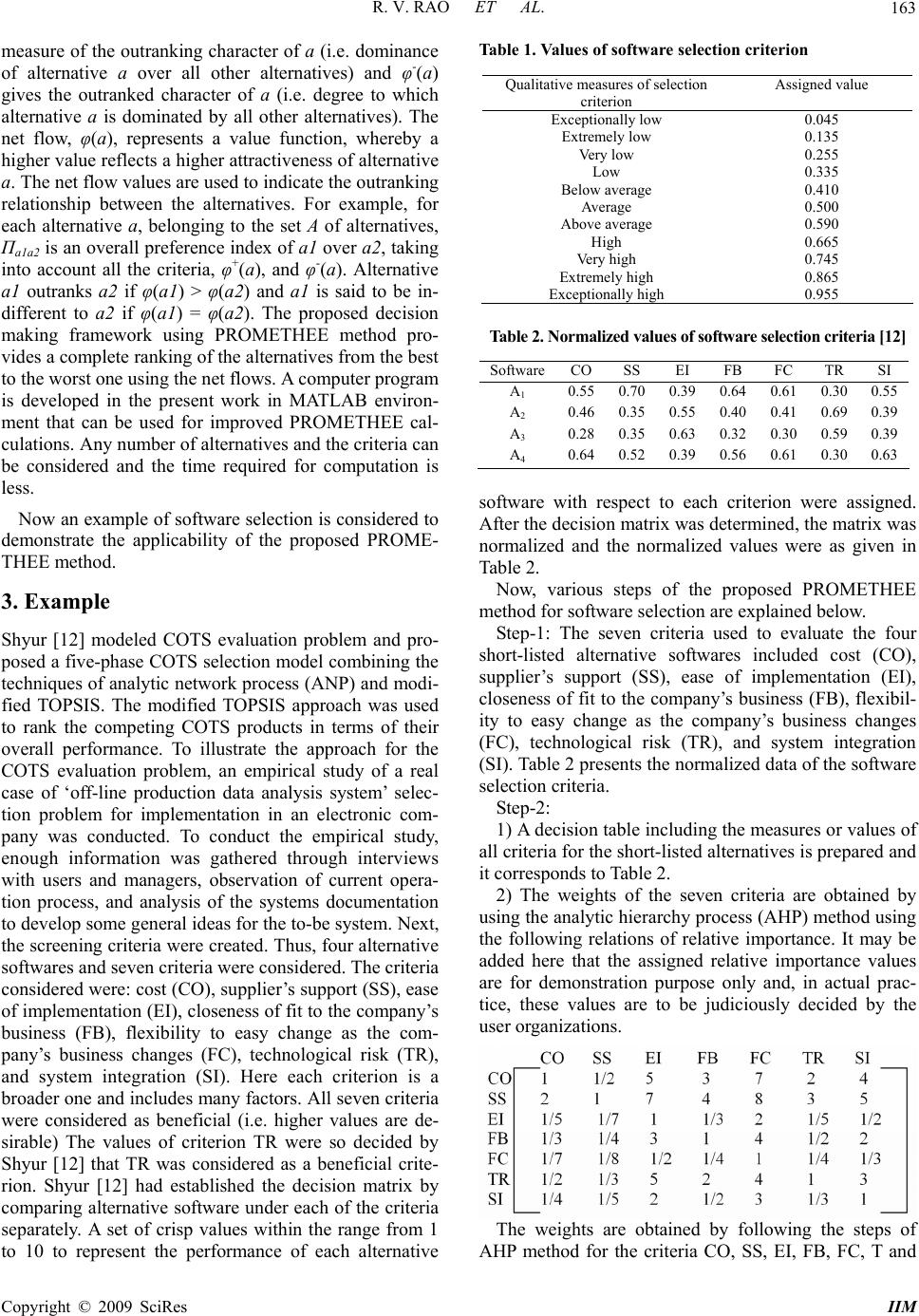 R. V. RAO ET AL. 163 measure of the outranking character of a (i.e. dominance of alternative a over all other alternatives) and φ-(a) gives the outranked character of a (i.e. degree to which alternative a is dominated by all other alternatives). The net flow, φ(a), represents a value function, whereby a higher value reflects a higher attractiveness of alternative a. The net flow values are used to indicate the outranking relationship between the alternatives. For example, for each alternative a, belonging to the set A of alternatives, Пa1a2 is an overall preference index of a1 over a2, taking into account all the criteria, φ+(a), and φ-(a). Alternative a1 outranks a2 if φ(a1) > φ(a2) and a1 is said to be in- different to a2 if φ(a1) = φ(a2). The proposed decision making framework using PROMETHEE method pro- vides a complete ranking of the alternatives from the best to the worst one using the net flows. A computer program is developed in the present work in MATLAB environ- ment that can be used for improved PROMETHEE cal- culations. Any number of alternatives and the criteria can be considered and the time required for computation is less. Now an example of software selection is considered to demonstrate the applicability of the proposed PROME- THEE method. 3. Example Shyur [12] modeled COTS evaluation problem and pro- posed a five-phase COTS selection model combining the techniques of analytic network process (ANP) and modi- fied TOPSIS. The modified TOPSIS approach was used to rank the competing COTS products in terms of their overall performance. To illustrate the approach for the COTS evaluation problem, an empirical study of a real case of ‘off-line production data analysis system’ selec- tion problem for implementation in an electronic com- pany was conducted. To conduct the empirical study, enough information was gathered through interviews with users and managers, observation of current opera- tion process, and analysis of the systems documentation to develop some general ideas for the to-be system. Next, the screening criteria were created. Thus, four alternative softwares and seven criteria were considered. The criteria considered were: cost (CO), supplier’s support (SS), ease of implementation (EI), closeness of fit to the company’s business (FB), flexibility to easy change as the com- pany’s business changes (FC), technological risk (TR), and system integration (SI). Here each criterion is a broader one and includes many factors. All seven criteria were considered as beneficial (i.e. higher values are de- sirable) The values of criterion TR were so decided by Shyur [12] that TR was considered as a beneficial crite- rion. Shyur [12] had established the decision matrix by comparing alternative software under each of the criteria separately. A set of crisp values within the range from 1 to 10 to represent the performance of each alternative Table 1. Values of software selection criterion Qualitative measures of selection criterion Assigned value Exceptionally low 0.045 Extremely low 0.135 Very low 0.255 Low 0.335 Below average 0.410 Average 0.500 Above average 0.590 High 0.665 Very high 0.745 Extremely high 0.865 Exceptionally high 0.955 Table 2. Normalized values of software selection criteria [12] SoftwareCOSS EI FB FC TR SI A1 0.55 0.70 0.39 0.64 0.61 0.300.55 A2 0.46 0.35 0.55 0.40 0.41 0.690.39 A3 0.28 0.35 0.63 0.32 0.30 0.590.39 A4 0.64 0.52 0.39 0.56 0.61 0.300.63 software with respect to each criterion were assigned. After the decision matrix was determined, the matrix was normalized and the normalized values were as given in Table 2. Now, various steps of the proposed PROMETHEE method for software selection are explained below. Step-1: The seven criteria used to evaluate the four short-listed alternative softwares included cost (CO), supplier’s support (SS), ease of implementation (EI), closeness of fit to the company’s business (FB), flexibil- ity to easy change as the company’s business changes (FC), technological risk (TR), and system integration (SI). Table 2 presents the normalized data of the software selection criteria. Step-2: 1) A decision table including the measures or values of all criteria for the short-listed alternatives is prepared and it corresponds to Table 2. 2) The weights of the seven criteria are obtained by using the analytic hierarchy process (AHP) method using the following relations of relative importance. It may be added here that the assigned relative importance values are for demonstration purpose only and, in actual prac- tice, these values are to be judiciously decided by the user organizations. The weights are obtained by following the steps of AHP method for the criteria CO, SS, EI, FB, FC, T and Copyright © 2009 SciRes IIM 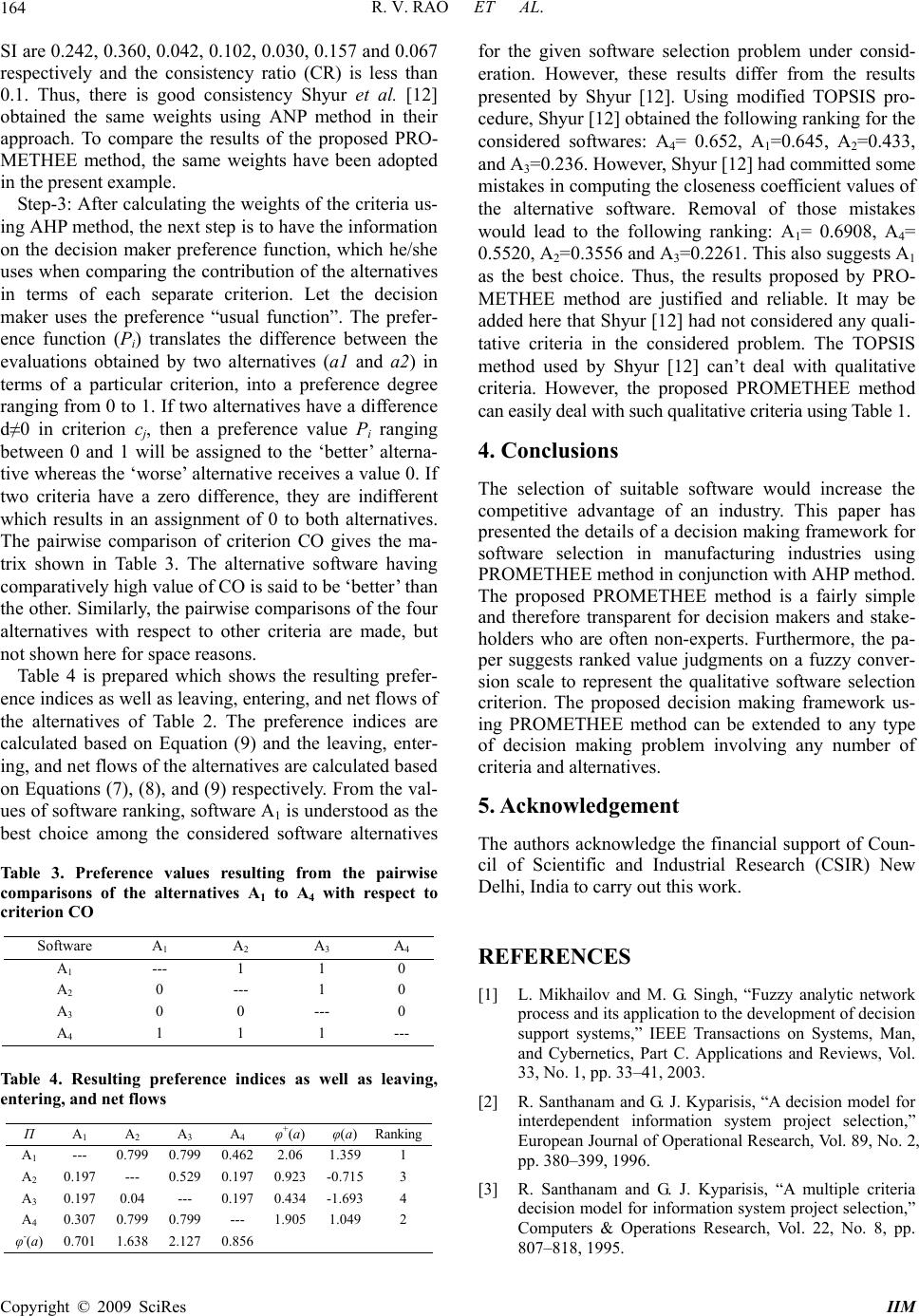 R. V. RAO ET AL. 164 SI are 0.242, 0.360, 0.042, 0.102, 0.030, 0.157 and 0.067 respectively and the consistency ratio (CR) is less than 0.1. Thus, there is good consistency Shyur et al. [12] obtained the same weights using ANP method in their approach. To compare the results of the proposed PRO- METHEE method, the same weights have been adopted in the present example. Step-3: After calculating the weights of the criteria us- ing AHP method, the next step is to have the information on the decision maker preference function, which he/she uses when comparing the contribution of the alternatives in terms of each separate criterion. Let the decision maker uses the preference “usual function”. The prefer- ence function (Pi) translates the difference between the evaluations obtained by two alternatives (a1 and a2) in terms of a particular criterion, into a preference degree ranging from 0 to 1. If two alternatives have a difference d≠0 in criterion cj, then a preference value P i ranging between 0 and 1 will be assigned to the ‘better’ alterna- tive whereas the ‘worse’ alternative receives a value 0. If two criteria have a zero difference, they are indifferent which results in an assignment of 0 to both alternatives. The pairwise comparison of criterion CO gives the ma- trix shown in Table 3. The alternative software having comparatively high value of CO is said to be ‘better’ than the other. Similarly, the pairwise comparisons of the four alternatives with respect to other criteria are made, but not shown here for space reasons. Table 4 is prepared which shows the resulting prefer- ence indices as well as leaving, entering, and net flows of the alternatives of Table 2. The preference indices are calculated based on Equation (9) and the leaving, enter- ing, and net flows of the alternatives are calculated based on Equations (7), (8), and (9) respectively. From the val- ues of software ranking, software A1 is understood as the best choice among the considered software alternatives Table 3. Preference values resulting from the pairwise comparisons of the alternatives A1 to A4 with respect to criterion CO Software A1 A 2 A 3 A 4 A1 --- 1 1 0 A2 0 --- 1 0 A3 0 0 --- 0 A4 1 1 1 --- Table 4. Resulting preference indices as well as leaving, entering, and net flows Π A1 A 2 A 3 A 4 φ+(a) φ(a) Ranking A1 --- 0.799 0.799 0.462 2.06 1.3591 A2 0.197 --- 0.529 0.197 0.923 -0.7153 A3 0.197 0.04 --- 0.197 0.434 -1.6934 A4 0.307 0.799 0.799 --- 1.905 1.0492 φ-(a) 0.701 1.638 2.127 0.856 for the given software selection problem under consid- eration. However, these results differ from the results presented by Shyur [12]. Using modified TOPSIS pro- cedure, Shyur [12] obtained the following ranking for the considered softwares: A4= 0.652, A1=0.645, A2=0.433, and A3=0.236. However, Shyur [12] had committed some mistakes in computing the closeness coefficient values of the alternative software. Removal of those mistakes would lead to the following ranking: A1= 0.6908, A4= 0.5520, A2=0.3556 and A3=0.2261. This also suggests A1 as the best choice. Thus, the results proposed by PRO- METHEE method are justified and reliable. It may be added here that Shyur [12] had not considered any quali- tative criteria in the considered problem. The TOPSIS method used by Shyur [12] can’t deal with qualitative criteria. However, the proposed PROMETHEE method can easily deal with such qualitative criteria using Table 1. 4. Conclusions The selection of suitable software would increase the competitive advantage of an industry. This paper has presented the details of a decision making framework for software selection in manufacturing industries using PROMETHEE method in conjunction with AHP method. The proposed PROMETHEE method is a fairly simple and therefore transparent for decision makers and stake- holders who are often non-experts. Furthermore, the pa- per suggests ranked value judgments on a fuzzy conver- sion scale to represent the qualitative software selection criterion. The proposed decision making framework us- ing PROMETHEE method can be extended to any type of decision making problem involving any number of criteria and alternatives. 5. Acknowledgement The authors acknowledge the financial support of Coun- cil of Scientific and Industrial Research (CSIR) New Delhi, India to carry out this work. REFERENCES [1] L. Mikhailov and M. G. Singh, “Fuzzy analytic network process and its application to the development of decision support systems,” IEEE Transactions on Systems, Man, and Cybernetics, Part C. Applications and Reviews, Vol. 33, No. 1, pp. 33–41, 2003. [2] R. Santhanam and G. J. Kyparisis, “A decision model for interdependent information system project selection,” European Journal of Operational Research, Vol. 89, No. 2, pp. 380–399, 1996. [3] R. Santhanam and G. J. Kyparisis, “A multiple criteria decision model for information system project selection,” Computers & Operations Research, Vol. 22, No. 8, pp. 807–818, 1995. Copyright © 2009 SciRes IIM 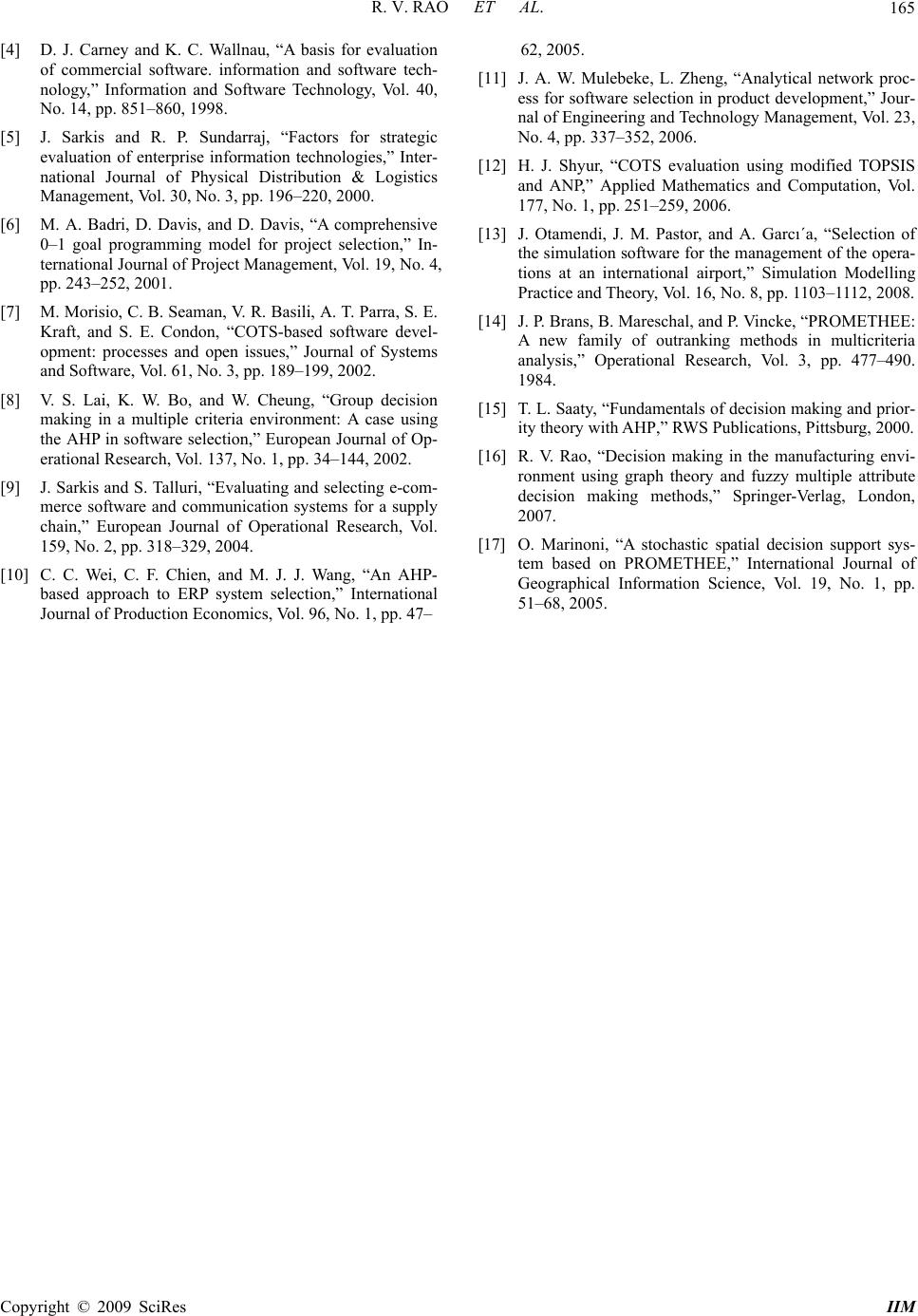 R. V. RAO ET AL. Copyright © 2009 SciRes IIM 165 [4] D. J. Carney and K. C. Wallnau, “A basis for evaluation of commercial software. information and software tech- nology,” Information and Software Technology, Vol. 40, No. 14, pp. 851–860, 1998. [5] J. Sarkis and R. P. Sundarraj, “Factors for strategic evaluation of enterprise information technologies,” Inter- national Journal of Physical Distribution & Logistics Management, Vol. 30, No. 3, pp. 196–220, 2000. [6] M. A. Badri, D. Davis, and D. Davis, “A comprehensive 0–1 goal programming model for project selection,” In- ternational Journal of Project Management, Vol. 19, No. 4, pp. 243–252, 2001. [7] M. Morisio, C. B. Seaman, V. R. Basili, A. T. Parra, S. E. Kraft, and S. E. Condon, “COTS-based software devel- opment: processes and open issues,” Journal of Systems and Software, Vol. 61, No. 3, pp. 189–199, 2002. [8] V. S. Lai, K. W. Bo, and W. Cheung, “Group decision making in a multiple criteria environment: A case using the AHP in software selection,” European Journal of Op- erational Research, Vol. 137, No. 1, pp. 34–144, 2002. [9] J. Sarkis and S. Talluri, “Evaluating and selecting e-com- merce software and communication systems for a supply chain,” European Journal of Operational Research, Vol. 159, No. 2, pp. 318–329, 2004. [10] C. C. Wei, C. F. Chien, and M. J. J. Wang, “An AHP- based approach to ERP system selection,” International Journal of Production Economics, Vol. 96, No. 1, pp. 47– 62, 2005. [11] J. A. W. Mulebeke, L. Zheng, “Analytical network proc- ess for software selection in product development,” Jour- nal of Engineering and Technology Management, Vol. 23, No. 4, pp. 337–352, 2006. [12] H. J. Shyur, “COTS evaluation using modified TOPSIS and ANP,” Applied Mathematics and Computation, Vol. 177, No. 1, pp. 251–259, 2006. [13] J. Otamendi, J. M. Pastor, and A. Garcı´a, “Selection of the simulation software for the management of the opera- tions at an international airport,” Simulation Modelling Practice and Theory, Vol. 16, No. 8, pp. 1103–1112, 2008. [14] J. P. Brans, B. Mareschal, and P. Vincke, “PROMETHEE: A new family of outranking methods in multicriteria analysis,” Operational Research, Vol. 3, pp. 477–490. 1984. [15] T. L. Saaty, “Fundamentals of decision making and prior- ity theory with AHP,” RWS Publications, Pittsburg, 2000. [16] R. V. Rao, “Decision making in the manufacturing envi- ronment using graph theory and fuzzy multiple attribute decision making methods,” Springer-Verlag, London, 2007. [17] O. Marinoni, “A stochastic spatial decision support sys- tem based on PROMETHEE,” International Journal of Geographical Information Science, Vol. 19, No. 1, pp. 51–68, 2005. |

